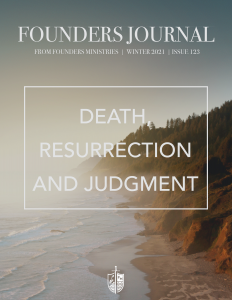Day of judgment! Day of wonders!
Hark! the trumpet’s awful sound,
louder than a thousand thunders,
shakes the vast creation round.
How the summons will the sinner’s heart confound!
Although many modern Christians are likely unacquainted with Newton’s classic hymn, it would be difficult to overlook the presence of its subject matter in Western culture. Even as the remaining vestiges of biblical Christianity grow dimmer in our increasingly secular age, the Bible’s teaching on the last judgment nevertheless continues to engage the imagination of the West. History bears witness to this longstanding fascination with hell and judgment, and throughout the centuries attempts to portray these themes can be found on the page, canvas, staff, and more recently, the camera reel. One might think of Dante, whose epic journey to Paradiso led him first led him through that suffering city, or perhaps recall the macabre works of the great medieval and Renaissance painters like Giotto di Bondone’s Last Judgment (1306), and Hieronymus Bosch’s surreal triptych, Garden of Earthly Delights (c. 1500). Composers like Giuseppe Verdi have also tried to represent the final judgment through the medium of music, and his requiem Dies Irae (1874), with its crescendo of frantic strings and pounding drums, provides one notable example. Similarly, the silver screen has presented moviegoers with depictions of hell from the earliest days of cinema with films like L’Inferno (1911), to the current plethora of over-the-top horror flicks.
Although trying to convey the terrors of that final day, many portrayals of hell and judgment rely more upon the fancies of their authors, artists and composers than the biblical testimony on the matter. These sources—Hollywood perhaps being the primary offender—often shape our understanding over and above Scripture, and this is a regrettable fact considering the gravity of the subject. Thankfully, the Second London Confession’s thirty-second and final chapter on the last judgment brings clarity to this often-misunderstood topic. Just as the Poet had Virgil to guide him through the depths of the Inferno, it is fitting that we too have a guide to help us navigate this important doctrine, the illustrious seventeenth-century Particular Baptist, Benjamin Keach (1640–1704). As both a signatory of the Confession and a prolific writer, Keach offers valuable insight into the Confession’s teaching on the subject. More importantly, however, Keach helps to illuminate the Bible’s teaching on that great day of judgment and wonder.
The Coming Harvest
The Confession’s statement on the last judgment consists of three paragraphs which correspond broadly to three related aspects of the doctrine: the first paragraph speaks to the reality of the final judgment, the second paragraph highlights the nature of the final judgment, and the third paragraph provides several important applications derived from the doctrine. The first paragraph reads:
God hath appointed a Day wherein he will judge the world in Righteousness, by Jesus Christ; to whom all power and judgment is given of the Father; in which Day not only the Apostate Angels shall be judged; but likewise all persons that have lived upon Earth, shall appear before the Tribunal of Christ; to give an account of their thoughts, Words, and deeds, and to receive according to what they have done in the body, whether good or evil.
The Confession first affirms the certainty of that fixed day on which God will judge the world. Likewise, the day of judgment featured prominently throughout Keach’s writings. In his exposition of Luke 16:22, Keach guaranteed that one day, because of sin, “all men must die,” and all must pay the debt of death. In his Tropologia, Keach drew from Matthew 13:39 to highlight the inescapable day of judgment. Commenting on Jesus’ parable of the weeds, Keach noted that both sinners and God’s elect now share a common field: “In a field grows wheat and tares, good and evil seed; so in this world there are good and evil men, saints and sinners, which God would have grow together, like the wheat and tares, until the harvest.” At present, the seeds sown continue to ripen, but one day the field will be ready for that great spiritual harvest that will separate the godly from the ungodly:
When the harvest is ripe, it is cut down; the husbandman sends reapers into the field: so when all the elect are ripe for heaven, and wickedness is grown to full maturity, so that ungodly ones are all ripe for hell, the end of the world will come, and then God will send reapers into the field, which are the holy angels; and they will put down, and gather out of the field, all things that offend, and them that do iniquity.
Although the husbandman waits patiently, the time fast approaches when his bearing with wicked men will come to an end, and at that time God “will not till, plow, or sow the field of the world any more; no more Gospel to be preached, nor graces or gifts to be distributed, when this harvest is ended.” On that discriminating day of wonders, said Keach, all persons will appear before the Christ’s dread tribunal and he “will judge the world . . . all men, according to their works.”
Abandon All Hope. . .
Whereas the first paragraph emphasizes the universal nature of the final judgment, the second paragraph delineates mankind into two groups: God’s elect who will go into everlasting life in the presence of God, and the reprobate who will be cast into eternal torments and everlasting destruction. The second paragraph of the chapter states:
The end of God’s appointing this Day, is for the manifestation of the glory of his Mercy, in the Eternal Salvation of the Elect; and of his Justice in the Eternal damnation of the Reprobate, who are wicked and disobedient; for then shall the Righteous go into Everlasting Life, and receive that fulness of Joy, and Glory, with everlasting reward, in the presence of the Lord: but the wicked who know not the Gospel of Jesus Christ, shall be cast into Eternal torments, and punished with everlasting destruction, from the presence of the Lord, and from the glory of his power.
Keach himself explicated upon these two groups in his sermon A Trumpet Blown in Zion. Delivered in 1693—nearly fifty years before Edwards famously stepped foot into the pulpit at Enfield—Keach’s fiery exposition of Matthew 3:12 and Jesus’ metaphor of the wheat and the chaff offered grave, forceful warnings of impending judgment for those outside of Christ. The wheat, wrote Keach, represents the elect who, like the grains which must be procured through much pain and effort, have had their spiritual convictions plowed up and their hearts sown with the grace of God. Keach continued: “Believers may be compared to wheat upon this respect, Christ takes much pains (to speak after the manner of men) with his own elect, not only by plowing, manuring, but by sowing, watering, weeding, fanning and purging them like wheat.” Just as wheat is able to endure cold and frost, and all manner of bitter weather, so too do God’s elect withstand trials and persecutions by the grace of the Spirit. The elect are those who, like pure wheat, will be placed in Christ’s garner, which, wrote Keach, “is meant heaven itself.” There, said Keach, “shall in no wise enter into it anything that defileth, neither whatsoever worketh abomination, or that make a lie, but they that are written in the Lamb’s Book of Life.” These will be invited to that great banquet and enter into heaven’s eternal rest in the presence of God.
Conversely, explained Keach, the chaff in Christ’s metaphor are the hypocrites and the ungodly, especially those who, like the worthless fodder that cleaves to the wheat, infiltrate the church but will inevitably be purged by Christ’s winnowing fan. Although oftentimes giving off the appearance of being true saints, inwardly the chaff possess “no substance, having mere dry, barren and empty souls.” The chaff, Keach further explained, are “full of vain words and foolish talk,” and possess “vain, carnal, proud and empty heart[s].” Such persons, argued Keach, “are not like to ascend God’s holy hill, nor abide in his tabernacle,” and their ultimate end is in God’s unquenchable fire.
Throughout his works, Keach wrote at length on the nature of the punishment of the wicked. In his Tropologia, Keach recognized the disagreement among exegetes concerning the literal nature of fire described in Scripture in passages like Matthew 3:12 and 13:42, and at least in this particular work he was reluctant to take a side on whether “it be real fire or not.” Elsewhere, however, Keach allowed that the fire could be a literal, physical flame, albeit unlike anything known to man in this world: In a sermon on Luke 16:23 and the rich man in torment, Keach noted that hellfire prepared for the ungodly exceeds the severity of any earthly fire in that it torments both body and soul alike:
Both soul and body too shall be tormented for evermore, when the bodies of men have been tormented, their souls have been at ease, and sustained them under their outward sorrows, but in hell the soul will be tormented as well as their bodies; the soul will be tormented in one fire, while the body is tormented in another.
Moreover, unlike ordinary fire, hellfire does not radiate light: “If therefore the fire of hell be material fire, yet it will not be like our common fire, the property of which is to give light; but it will be dark fire: God can change that quality of fire, if be please, tho’ it may have all other properties.” For Keach, The darkness of hell points to one of the most harrowing aspects of the last judgment, namely, a spiritual darkness that entails a complete separation from God and his grace for all eternity.
Although Giotto’s Last Judgment, with its portrayal of lost souls being cast down into hell and suffering all manner of torments by Satan and his devils, attempted to touch upon the severity of the sinner’s fate—even Keach noted that one of the miseries of hell is that the condemned would spend eternity alongside the myriads of fallen angels—this and similar depictions obfuscate the most important aspect of God’s judgment: the outpouring of his wrath. It is not Satan and his angels nor Dante’s ironic punishments of the damned that should cause sinners to tremble at the thought of judgment, but, warned Keach, falling into the hands of the living God. While it may provide some reference point to the severity of God’s judgment, for Keach not even the pain inflicted by earthly fire can fully convey the nature of God’s wrath. Appealing to Psalm 90:11, Keach suggested that the torments of God’s wrath are “inconceivable, or beyond all understanding.” Although physical fire can inflict excruciating pain upon the body, God’s wrath “is far more intollerable than any fire into which any mortal was ever cast.” Similarly, wrote Keach, earthly fire “[is] nothing to the wrath of God, when God kindles it in the consciences of men, nor to hell fire.” Unlike physical fires that can be abated, Keach likened God’s wrath to a fire that is ceaseless and unextinguishable because, he further explained: “It is to satisfy divine justice . . . yet no satisfaction can [sinners] by suffering make, for the wrong done to the holiness and justice of God.” Consequently, as illustrated in Keach’s sobering analogy, God’s wrath will eternally feed upon the condemned “like as a hungry man eats that which satisfieth him not.” In that place, the condemned “will have a judgment without mercy, sorrow without joy, pain without cease, darkness without light,” and they will roar and howl—hating both themselves and their Creator—against God and his elect for all eternity. Thus, in that great judgment upon sinners, wrote Keach, “all hopes of being saved die when they die: their expectation perishes, and all means of grace cease: the door of mercy is shut for ever.”
Terror for the Wicked . . .
Painters have frequently touched upon Scripture’s teaching about the inevitability of death and judgment, and Peter Bruegel’s macabre work The Triumph of Death (c. 1562) provides one such example. Death, represented by the artist as an innumerable army of skeletons searching out its victims, ultimately overcomes all persons regardless of their status. One scene depicts a skeleton taunting a king with an hourglass that has run out of time, while another section of the painting reveals knights hopelessly trying to fend off the endless waves of death’s mercenaries. Men, women and children, nobles and peasants, and monks and priests all succumb to death’s ruthless and inescapable grasp. Likewise recognizing that death fast approaches for all persons, the Confession’s final paragraph draws out several important applications from the doctrine of the last judgment:
As Christ would have us to be certainly perswaded that there shall be a day of judgment, both to deter all men from sin, and for the greater consolation of the godly, in their adversity, so will he have that day unknown to men, that they may shake off all carnal security, and be always watchful, because they know not at what hour, the Lord will come; and may ever be prepared to say, Come Lord Jesus, Come quickly, Amen.
Like Bruegel, Keach’s exposition of Luke 16 also affirmed the inevitability of death and judgment. Because of sin, death comes to all, whether rich or poor: “Kings die as well as peasants; Caesar rides in triumph one day, and the next day stabbed to death. Alexander that conquered the world was conquered by death. Nay, grace itself exempts no man from death; the righteous die as well as the wicked.”
Furthermore, Keach warned that death and judgment can come at any time, and thus sinners’ time on earth is never guaranteed. Like Edwards’ spider dangling precariously over the fiery pit by a slender strand, Keach too cautioned his readers against any false sense of security:
That many persons are very near being cast into hell, even every ungodly and unbelieving sinner. O, how soon may some of you, if in your sins, feel how intolerable the torments of hell are? It is not afar off, no, there is only a small thread of life between sinners and eternal torments.
The life of man is like the wind that speedily passes away, a cloud that vanishes, and a flower that quickly fades. Thus, Keach cautioned, one ought not presume upon certainty of tomorrow: repent now while there is still time.
For Keach, both the terrible nature and fast-approaching time of God’s impending judgement ought to instill terror into the hearts of unbelievers, a sentiment he raised in a sermon on Matthew 13:47–50 and Jesus’ parable of the net. Although many of God’s elect have not yet been caught, the net, understood by Keach as the gospel, will one day be gathered back to the shore and “all means of making the good better, or the bad good, shall cease for ever.” That is, the current season of repentance is soon coming to an end, and sinners will ultimately face the reality that “the harvest is past, the summer is ended, and we are not saved.” One day, those unrepentant will hear those dreaded words, “depart ye from me, ye cursed, into everlasting fire.” Thus, the preacher pleaded:
How might this awaken sinners, and be a means to turn them from spiritual darkness to light; and from Satan, the prince of darkness, to God: Oh! that these closing, direful, and amazing lines, might turn many to righteousness, to believe, repent, and obey the Gospel, before the Lord Jesus come in flaming fire, rendering vengeance upon all that know not God nor obey the Gospel.
“Death may be nearer than you are aware of,” warned Keach, “and that is the evil day to all Christless sinners, then they go to hell; dare you defer seeking Jesus Christ, ‘boast not thyself of to-morrow, for thou knowest not what one day may bring forth.’”
. . . Consolation for the Godly
Keach, like the Confession, noted the “vast difference between the state of the godly and ungodly at death.” Although it does not provoke Christians to terror as it does for those outside of Christ, Keach argued that the impending judgment ought to prompt reflection upon one’s own estate:
Oh what a motive should this be to us all; God weighs our persons, our graces, our gifts, our duties, and all our services, in scales. Take heed you are not found too light, found wanting as be sure you will if you be found chaff, when put into the balance of the sanctuary.
Appealing to 1 Corinthians 11:32, Keach elsewhere urged Christians to “examine and try ourselves, judge ourselves, since the time will come which will try every person.” In his Trumpet Blown in Zion, Keach likewise suggested this same introspection so that those in the church “would not be found chaff at the great day.” All sin will eventually be laid bare, thus Keach implored his hearers to find refuge only in the mercies of Christ and his free grace: “Be sure build on Christ alone, and see that that faith thou hast in him, be the faith of God’s elect, which sanctifies both heart and life, and is attended with good fruits.”
Furthermore, whereas the last judgment provides a dire warning to the ungodly, Keach highlighted the comfort and consolation that doctrine provides for Christians. First, Keach reminded Christians that God’s wrath is appeased towards them, and that “Christ’s blood has quenched this dreadful fire.” Christ, he continued, “hath born it, and allay ‘d it, nay, quite put it out, so that you shall never feel the burning or tormenting nature thereof.” Christ will not lose one grain of his spiritual wheat, thus the saints can have full confidence that their reward on that last day will be heaven itself. Thus, expressed Keach:
Let [Christians] lift up their hearts with joy! What a blessed and happy condition are they in now! But what will their state be when this life is ended? Such need not to fear death; for, as their souls go then to Christ, so when Christ comes, he will bring them with him; “they shall appear with him in glory.” What a harvest of joy.
Keach elsewhere spoke of the “thrice happy” estate of the redeemed. First, for those trusting in Christ and his righteousness alone, the law will be silent against them on that great day, “being fully answered.” Moreover, the Judge will smile upon the elect “as the favourites of heaven,” and will say to them “Well done, good and faithful servant.” Third, noted Keach, the saints will be free from their earthly troubles. The doctrine of the last judgment reassures believers that present trials and suffering will one day cease, and “though you have sorrow here, sorrow now, yet you shall be comforted, being delivered from whatsoever is evil, and possess whatsoever is truly good, and when you die you shall partake thereof.” Keach himself was no stranger to persecution—he, along with many of his fellow dissenters, faced imprisonment during the reign of Charles II— thus the doctrine likewise provides comfort for those reviled and facing martyrdom for the faith, and encourages believers to stand firm in the gospel knowing that one day they will be vindicated.
Finally, reflecting upon the doctrine of the last judgment ought to provoke the redeemed to praise God:
Let the redeemed of the Lord rejoice and magnify the God of their salvation, who hath given them good hope through grace, that they are delivered from wrath to come, by being called out of spiritual darkness into Christ’s marvellous light, and by him have escaped that dreadful doom, of being cast into utter darkness.
To borrow from an Augustinian sentiment, all people are born into the same, sinful lump. Thus, wrote Keach, recognizing one’s own deliverance from the coming judgment brings the wonders of God’s glorious grace and work of salvation into greater view:
We refer the excellency of divine grace; all men, my brethren, naturally are alike vile, sinful, and odious by sin; there is no difference; it is only that mighty work of the Spirit of God upon the souls of his elect, that makes them so glorious, amicable, and precious.
Therefore, Keach implored, “sing praises to our God, sing praises to our King, sing praises to our Judge, sing praises.”
Conclusion
Given the current confusion on the topic—and especially if recent surveys on the state of evangelicalism are accurate—readers today would be wise to consider the Confession’s and Keach’s teaching on the last judgment. As we have seen, the doctrine contains both hope for the godly and despair for the ungodly; it offers consolation to the redeemed and grave warnings for those outside of Christ. Although a difficult doctrine, it is an important one. Thankfully, both the Second London Confession and the voluminous writings of Keach offer readers the precision needed to navigate this crucial topic. Like Newton, one of Keach’s own hymns encapsulates this great scriptural teaching:
What Man is He that Liveth here,
and Death shall never see?
Or, from the hand of the dark Grave,
can, Lord, deliver’d be?
But blest are they, who die in Christ,
Their Death to them is Gain;
Their Souls do go to Paradice;
The Wicked go to Pain.
Praised be God for Jesus Christ,
Who gives such Victory
Unto thy Saints, o’er Sin and Death;
Sing Praise continually.
The Godly ly in a sweet Sleep,
They sleep in Jesus do;
And no more Pain, no Sorrow shall
for ever undergo.
























